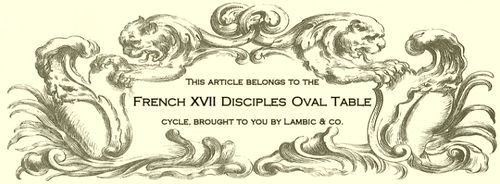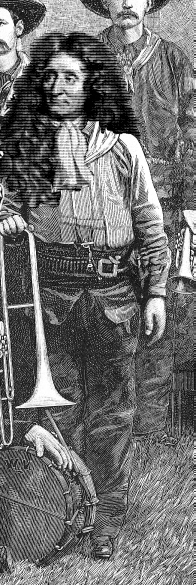Jean le Vis de Nîmes
“This fancy dress has a certain "Jeans ay qua" to it.”
– Oscar Wilde when admiring his latest mail order
“A Jeans, a Jeans, my Empire for a Jeans!”
– Emperor Mee No Fan Nee of the Thong Dynasty when struggling to get into his fifty-fold ceremonial robe.
Jean le Vis de Nîmes (born 1651 in Montfroc (France), died 1723 in Beato Francisco (US-to-be)) was a most innovative and at the same time very conservative tailor. Conservative because of his stubbornness in sticking to oldfashioned (but sturdy) materials, innovative in his way of trying to market them as a new fad. I have named: the inventor of the "Blue Jeans"!
Montfroc and Nîmes[edit | edit source]
Life was hard in Montfroc. Boring, actually. Boring someone's pants off was more popular than "jeu de boules", and that says a lot in France. Tired of boring pants off, Jean decided to go to Nîmes, and to become an apprentice in the cloth industry. There he learned how to weave and dye the sturdy kind of cloth Nîmes was famous for. It was used mainly for sailors' trousers and kit bags, but he thought of it as a possible new Paris fashion. Once his diplome of "Maître Couturier ès Trucs Bleu Marin", meaning "This person can make sailors' trousers as well as anybody else", in the revolver pocket of his sailors' trousers, he headed for Paris, the cultural capital of Europe back then.
Paris[edit | edit source]
A fashionable nobleman[edit | edit source]
He tried to establish himself in Paris, but had to cope with the Tailors' Guild. They sharply refused his ideas of combining upper-class with lower-class, tradition with innovation. Fortunately, a local playwright, Molière, showed interest in Le Vis' clothing ideas (in other clothing ideas as well...), and was willing to provide for a workshop. There he could refine his trendy sailors' trousers, using the sturdy blue cloth he had learned to weave back in Nîmes. When asked for his name, he added "de Nîmes", to give it a more noble touch. When his trousers' line began to take off, the Parisian customers used to call them "Jean's", or "Le Vis'", or even "De Nîmes'".
Dressing the Disciples[edit | edit source]
It was also Molière who introduced Le Vis to the XVII Disciples Oval Table, enjoying the idea of having next to him a genuine fashion phenomenon. At one Convention, Le Vis got the Disciples to dress entirely in his fashion, expanding the idea to the upper half of the body and even the hat as well. Only La Fontaine couldn't be persuaded to take off his wig.
Although Jean Bart had dressed like the others at that one occasion, he never adopted the fasion: he preferred a more flamboyant style for himself and his crew. Le Vis never forgave him this, but kept quiet in order not to break up the jolly atmosphere of the Conventions.
Off to the colonies[edit | edit source]
After the Last Convention, in 1700, he decided to try his luck in the colonies, and set of to the Americas. He felt that his clothes' line could be more useful to the local pioneers. The fad had worn out in France very quickly anyway. Over there, very few people noticed what "De Nîmes" stood for, and shortened it into "denim". "Jean" being considered a woman's name there, he called himself "John" instead, and the word "Jean's" only stayed to refer to his products in adverts. The words "Le Vis" being clumsily painted on the panel above his shop, they were remembered solely as "LEVIS", and eventually nobody made the link with France anymore.


